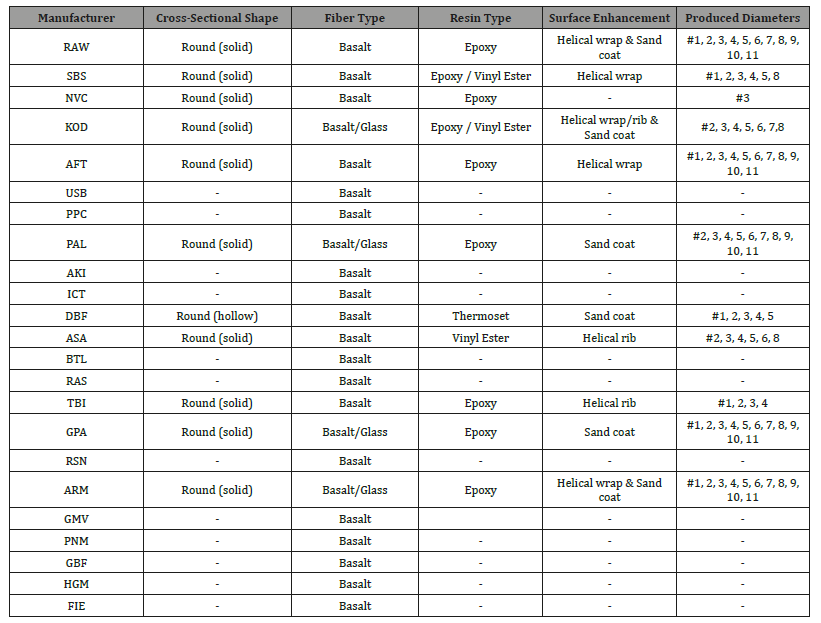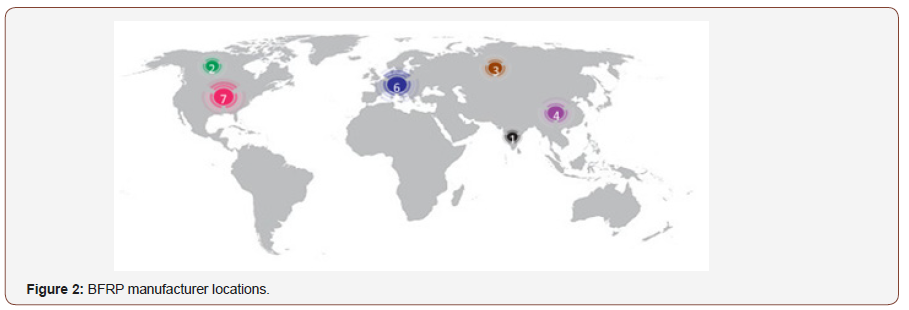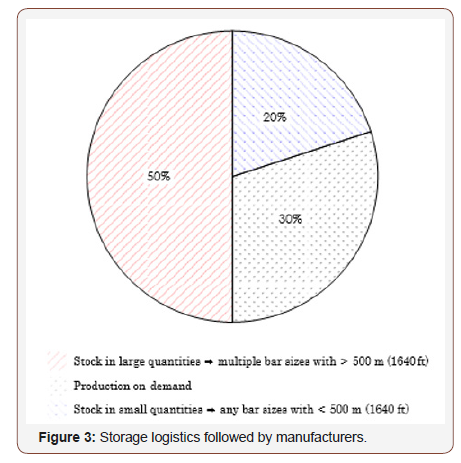 Research Article
Research Article
Current Market Trends of Basalt FRP Rebars
Srichand Telikapalli1*, André Schmidt2 and Raphael Kampmann1
1FAMU-FSU College of Engineering, USA
2Fachhochschule Muenster, Germany
Srichand Telikapalli, Civil Engineering Department, FAMU-FSU College of Engineering, Florida, USA.
Received Date: July 05, 2019; Published Date: July 10, 2019
Abstract
Concrete structures made with traditional black steel reinforcement are deteriorating at an alarming pace due to corrosion effects. Many research institutes across the globe are spending lots of resources to overcome this problem by replacing steel reinforcement with fiber reinforced polymer (FRP) rebars because these bars are corrosion resistant. FRP rebars are a product of composite materials with raw materials made from sized fibers and thermoset polymeric resin. The fibers can be made from various materials and glass fibers have been most dominant in the US market due to historical developments. However, basalt fiber reinforced polymer rebars (BFRP rebars) are now becoming more popular. With a significant increase in demand for such materials, the number of manufacturers increased notably over the past two decades. Because the production of FRP rebars has not been standardized yet, a wide range of products with several different material characteristics and mechanical strength are now available in the market. Due to these dissimilarities, proper standardization of material properties and an adequate definition of strength requirements have been a challenge for researchers. To evaluate the current trends in FRP rebar production and to capture an industry profile, 23 international BFRP manufacturers from 10 different countries were surveyed for specific material and production aspects. The survey mainly focused on production capacities, rebar types, material properties, and strength characteristics. It was found that majority of the produced rebars have a circular cross section with sand coat or helically wrapped surface to improve the bond-to-concrete property. BFRP rebar producers mostly manufacture their products on demand, and all manufacturers produce the most common size # 3 rebar, while 80 % of the manufacturers also produce # 5 rebars.
Keywords: Fiber reinforced polymer (FRP) rebars; Thermoset polymeric resin; Production capabilities; Manufacturer; Standardization
Abbreviations: Rebar: Reinforcing bars; FRP: Fiber reinforced polymer; BFRP: Basalt fiber reinforced polymer; CFRP: Carbon fiber reinforced polymer; GFRP: Glass fiber reinforced polymer
Introduction
Traffic loads are increasing significantly, and environmental effects are worsening day by day. Bridge infrastructure is deteriorating at a hazardous pace, specifically in coastal areas due to amplified chloride ingression. Major bridge infrastructure in coastal areas are directly exposed to seawater, vulnerable to severe corrosion of steel inside the structural components. For example, a survey conducted by the National Bridge Inventory (NBI) showed that, as of 2010, more than 146.000 bridges in the US are structurally deficient or functionally obsolete. A study conducted by FDOT District 7 between February 2003 and December 2013 in which the current status and the required repair costs of 54 (20 steel and 34 concrete) bridges were evaluated, showed that 76% of all repair costs would be necessary to alleviate damages due to corrosion [1,2]. The second most reason for concrete failure in structural components is spalling, which is caused by the increased internal pressure in structural components due to volume expansion of steel reinforcement during corrosion. Fiber Reinforced Polymer (FRP) rebars are predominantly used because they are a non-corrosive alternative [3]. Rebars made from basalt fibers were widely studied in the former Soviet Union during the cold war period and hence, they are now widely used in countries like Russia and Ukraine. Manufacturers in the US preferred glass fiber research over basalt fiber research in the early 1900s because of economical reason and ease in production; BFRP rebar products were lacking behind other FRP materials in the U.S.A. However, BFRP rebars are believed to have a promising future in replacing traditional black steel [4,5], CFRP, and GFRP [6] because of favorable properties most notably because of its high elastic modulus. While the International Code Council Evaluation Service (ICC-ES) has accepted FRP rebars as the reinforcement material for concrete structures [7], the standard specifications for BFRP rebars are not yet developed in the U.S. Though BFRP rebars have desirable strength properties, and can compete with other FRP rebars, the lack of standards and material defining criteria impede the escalating increase of vying products.
Nonetheless, due to serviceability requirements, need for resilient structures, and economical factors, FRP manufacturers started manufacturing BFRP rebars because they perform well and have better strength and elastic properties in comparison to other FRP rebars. According to a research conducted by Markets & Markets [8], it was estimated that BFRP rebar market growth would be up to $91 million by the year 2021. Hence, a key initiative for many Departments of Transportation is the progressive implementation of BFRP technology for concrete reinforcement in infrastructure projects, and therefore, into local and national design codes. To accomplish this goal the variety of products on the market has to be analyzed and specific data about available products have to be collected. In a successful effort to create a centralized database of all known BFRP manufacturers across the globe, a survey was conducted. Based on the manufacturers answers to the survey questions, location of the manufacturers, production logistics, production rates, type of raw materials used in the manufacturing process, cross-sectional shape of rebars, and sizes are presented in this research paper.
BFRP Rebar properties
The general production components of BFRP rebars can be seen in Figure 1 (from left to right). Basalt fibers manufactured from molten basaltic rocks are embedded in a polymeric resin matrix. Mainly, fibers are known for their high tensile strength-to-weight ratio and for corrosion resistance when they are combined with suitable thermoset resins to form rebars. Because FRP rebars are a composite materials, durability and strength of the final product highly depend on the ratio of the raw material quantities used in the production process. For example, the fiber volume is mainly responsible for the tensile strength of the FRP rebars, while the resin transmits the loads from fiber to fiber(Figure 1).

Methodology
To study the current market trends of BFRP rebars and to generate an industry profile, a survey was conducted with 23 BFRP rebar manufacturers and suppliers across ten different countries. The survey showed that all the manufacturers participated are actively producing BFRP rebars for concrete structures based on the demand and market requirements. Table 1 lists the contacted manufacturers. Several other manufacturers who produce BFRP rebars which do not meet the qualifications for structural applications exist across the globe. Those manufacturers were not included in this survey1. First, all listed manufacturers were contacted via phone call, email, or virtual meeting service, before sending a 17-question survey that addressed the most important aspects of production trends, rebar specifications, and manufacturer guaranteed material properties (both physical and mechanical). The questions also addressed raw material properties, and chemical make-up (types of resin and fibers). Based on the answers provided by the manufacturers, the market was analyzed, and the results are presented below (Table 1).
Table 1:Global BFRP suppliers.

Results and Discussion
A total of 23 manufacturers and suppliers were recognized worldwide. The first FRP rebars were found to be commercially available in the late 1980s, when the market demand for electromagnetic-transparent reinforcing systems increased. At that time, the technology was developed enough to provide a viable solution as internal reinforcement for concrete structures [9]. The survey showed that the used raw materials, production techniques, and production rate varies for individual manufacturer. It was also found that the stocking logistics are different for manufacturers across the world. Some of the manufacturers produce and stock in large quantities and some stock in small quantities while some manufacturers produce rebars on demand. Production logistics and stocking logistics play an important role while planning and implementing large scale projects or projects with changing demands. Therefore, this is an important factor for engineers during the planning phase of a project, because rebar availability may be vital to the completion of large-scale projects. Figure 2 shows location and number of manufacturers (indicated by circles) in each country. Table 2 lists the production rates and logistic aspects for each manufacturer. Figure 3 represents a pie chart that compares the different stocking logistics followed by the manufacturers. It can be seen that 50 % of the manufacturers stock rebars in large quantities (> 500 m or 1640 ft), while 20 % of them stock in small quantities (< 500 m or 1640 ft), the remaining 30 % produce rebar on demand. Based on the answers provided by the manufacturers, the physical properties and raw materials used in the production of rebars are shown in Table 3. It can be seen that most of the manufacturers produce rebars using epoxy resin and circular (solid) cross section with surface enhancement treatments. Surface enhancements help increase the friction at the interface between concrete and rebar to improve the interlocking effect, which improves the bond between the BFRP rebar and the concrete. This bond strength at the interface is known as the bondto- concrete property of the rebar, and it is important because it defines the uniformity or the composite action of the final structural concrete element (Figures 2,3)(Tables 2,3).
Table 2:Daily production rates of each manufacturer.

Table 3:Properties of rebar products from all manufacturers.



Conclusion
In an effort to study the current market trends of BFRP rebars, a survey was conducted in which 23 manufacturers from 10 different countries answered 17 questions related to production capacities, BFRP rebar types, material properties, and strength characteristics. Based on the manufacturer’s responses, the following conclusions were drawn:
1. The majority of BFRP rebar manufacturers are located in North America and Europe.
2. Most of the rebar products have a circular cross section and are sand coated with helical wraps to enhance the surface properties for increased bond-to-concrete strength.
3. Production rates and rebar storage differ widely between manufacturers all over the world. This directly relates to the availability of rebars and is an important consideration for large-scale projects or projects with changing demands.
4. BFRP rebar sizes vary from # 1 and # 12, while the most common sizes are # 3 and # 5. All manufacturers produce # 3 rebars whereas only 80 % of them produce # 5 rebars (at the time of this research).
Acknowledgement
The Authors would like to acknowledge the Florida Department of Transportation (FDOT) for a progressive approach to the implementation of emerging technologies in our infrastructure. This project would have not been possible without the financial assistance of the FDOT. Special thanks go to Steven Nolan and Chase Knight for pro- viding exceptional expertise and support throughout any research tasks related to FRP rebar technology.
Conflict of Interest
No conflict of interest.
References
- ASTM-International (2011) Standard Test Method for Ignition Loss of Cured Reinforced Resins, (D2584-11). West Conshohocken, USA.
- Fallaha S, Knight C, Nolan S (2017) Fdot gfrp-rc implementation - current status, projects and challenges. Report no, Florida Department of Transportation, USA.
- Micelli F, Nanni A (2004) Durability of frp rods for concrete structures. Construction and Building materials 18(7): 491–503.
- De Caso F, Matta F, Nanni A (2012) Fiber reinforced cement-based composite system for concrete confinement. Construction and Building Materials 32: 55-65.
- Nanni A, De Luca A, Jawaheri Zadeh H (2014) FRP Reinforced Concrete Structures – Theory, Design and Practice. CRC Press, USA.
- Kocaoza S, Samaranayakeb V, Nanni, A (2004) Tensile characterization of glass frp bars. Composites Part B 36: 127-134.
- International Code Council Evaluation Services (2017) Acceptance criteria for glass fiber–reinforced polymer (GFRP) bars for internal reinforcement of concrete members. Acceptance criteria 454, ICCES, USA.
- Markets and Markets (2016) Frp rebar market by resin type, by fiber type, by application-global forecasts to 2021. PR Newswire Association LLC, USA.
- Nanni A, De Luca A, Zadeh HJ (2014) Reinforced concrete with FRP bars: Mechanics and design. CRC Press, USA.
-
Srichand Telikapalli, André Schmidt, Raphael Kampmann. Current Market Trends of Basalt FRP Rebars. Cur Trends Civil & Struct Eng. 3(2): 2019. CTCSE.MS.ID.000557.
-
Fiber reinforced polymer (FRP) rebars, Thermoset polymeric resin, Production capabilities, Manufacturer, Standardization, Reinforcement, Elastic modulus, Transportation
-

This work is licensed under a Creative Commons Attribution-NonCommercial 4.0 International License.






